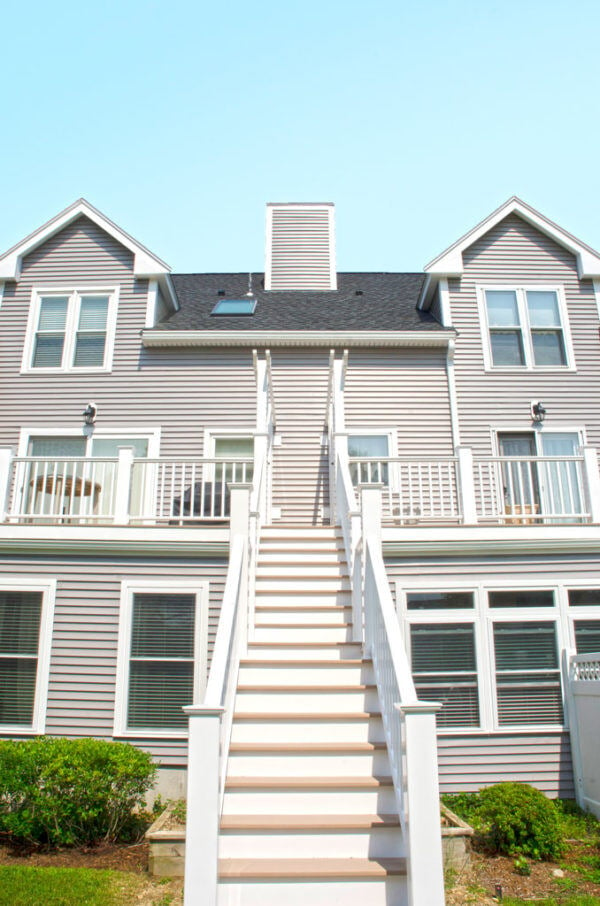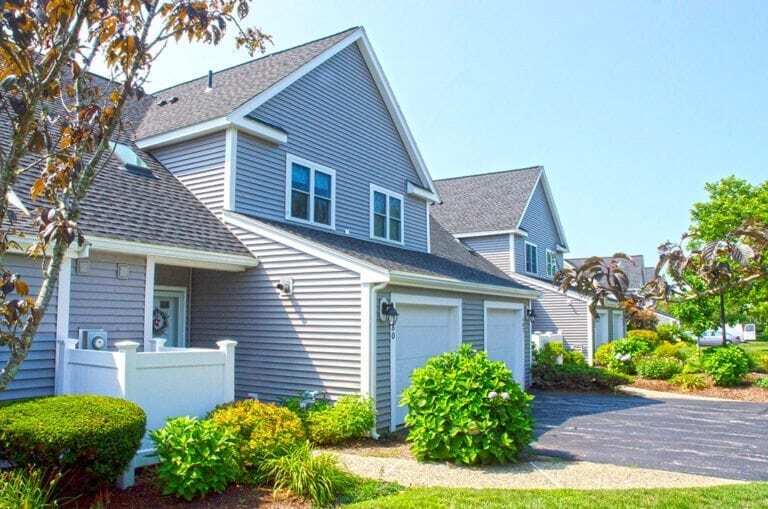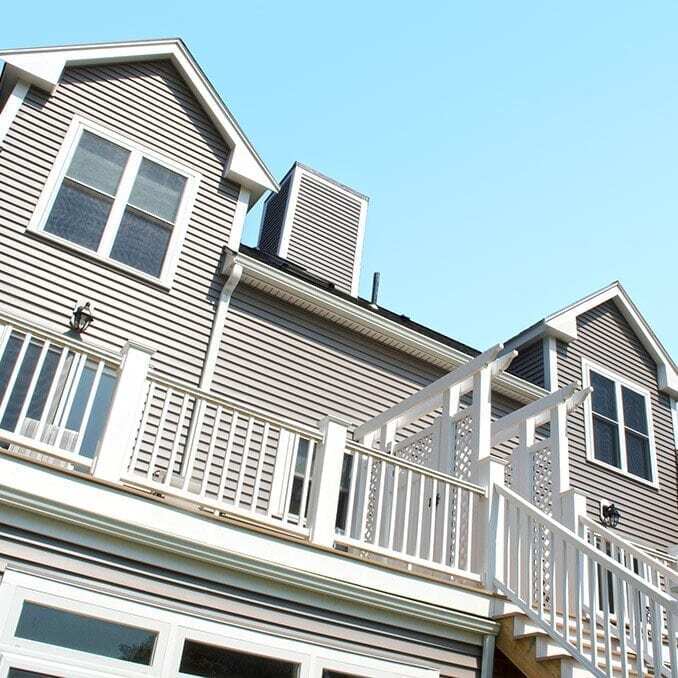Fairway Green starts fresh with SPS30 building envelope project

Quickly and efficiently build the materials you need to support your inbound marketing strategy. Drag and drop building blocks including testimonials, forms, calls-to-action, and more.
"We were spending a tremendous amount of money on solutions that weren't working. Meanwhile, the leaks were getting worse."
-Ray Hoefling, Association Board President
Time was running out for the owners of Fairway Green, a luxury townhome association within the White Cliffs community in Plymouth, Mass. Decades of exposure to coastal weather had taken their toll on the association’s aging roofing and siding. Spending more money in a never-ending cycle of spot repairs, painting, and patching no longer made sense. And leaking roofs and windows were damaging property and fraying nerves.
“We were spending a tremendous amount of money on solutions that weren’t working,” says board member Antonia Cosgrove. “Our 30-year-old buildings had been patched over the years. The result was nothing but a hodgepodge appearance of siding materials and colors. Meanwhile, the leaks were only getting worse.”
It was clear that a full makeover of each building was the best long term solution. “Now we had another challenge,” says association President Ray Hoefling. “Our reserves were nowhere near sufficient to do all 22 buildings at once. Property values and incomes were still reeling from the recession. And no one could tolerate a huge special assessment or a massive increase in common fees.”
The board decided the most palatable way to manage the multi-million dollar expense was to complete the work in phases. “We planned to do about a third of the buildings a year for three years,” says Hoefling. “And it seemed like a good compromise — until Eric Churchill from SPS said, ‘What if we could show you a better way?’”
Facts: Pervasive sheathing rot behind siding and at the roof to wall transitions due to improper flashing installation methods.
Options: Phased building envelope replacement, phased component replacement, and funding with reserve funds, special assessment, and/or a loan.
Path Forward: SPS30 Full building envelope restoration project funded with a 30-year loan.
“Complete building envelope replacement projects can feel overwhelming,” says SPS Planning Team Member Eric Churchill. “The numbers can be intimidating. And it’s easy to feel that your options are limited. We were familiar with the association’s financial concerns,” he says, “which is why the idea I shared with the board must have seemed crazy.”
Eric proposed a complete SPS30 project using long-life, low-maintenance materials. But instead of phasing the project over three years, SPS would complete the work on all 22 buildings in less than half that time. No special assessments or unusual increases in homeowner fees would be required.
The board was more than a little skeptical, says Hoefling. “I said, ‘Eric, I would love to wave a magic wand and replace the roofs, the siding, the windows, the doors, and skylights in all of these buildings all at once and have a brand new physical plant. But I don’t know how we make that happen without breaking the bank. We’ve got owners under duress.
“Eric said, ‘Let us work on that. Share your reserve study with us and your financials and your budget. Let us do some analysis and come back to you with our findings,’” recalls Hoefling. “We thought, ‘There’s no way SPS can do this.’ But Eric was confident.



Eric's confidence was based on experience — and an innovative approach to project development called the SPS Savings BluePrint.
“We walk clients step-by-step through a decision-making process that is collaborative, based on facts, and customized to each association’s circumstances,” says Eric. “The Savings BluePrint makes it easy for a board to choose the right long-term building envelope solution for their community because it shows how their decisions play out over 30 years.”
At Fairway Green, SPS conducted physical investigations and a comprehensive financial analysis before sharing their findings with the board. The results, says Hoefling, were eye-opening.
Fairway Green’s SPS Savings BluePrint included project pricing for three different options. The first was the cost to replace roofing, siding, and other building envelope components according to the original reserve study. The second option was the cost to perform the project in phases over three years. The third option was the cost to complete all 22 buildings in one continuous project.
Much to the board’s surprise, the least expensive option was completing the project all at once, even after factoring in the cost of financing. “On a raw numbers basis, it was about 20 percent less,” says Hoefling. “We thought the only way this would work was to do it in phases. But then SPS showed us the facts and the math.”
The savings can be attributed to a variety of factors, says Eric, starting with volume discounts on building materials purchased for one larger project. “Marshaling labor and resources for a single project is also less expensive than completing the work in phases.”
Fairway Green would also pay more for materials and labor by replacing building envelope components according to the reserve study. “Roofing and siding systems have to be tied together properly for the highest quality installation,” says Eric. “This process is much more efficient when both roofing and siding are replaced at the same time. When you replace components on a piecemeal basis, you often pay to do some of the same work twice.”
“Much to the board’s surprise, the least expensive option was completing the project all at once, even after factoring in the cost of financing.”
SPS walked the board through project financing, including a transparent 15-year plan detailing how the project would impact reserves and each homeowner’s common fee. The numbers showed that the least expensive solution was to increase the common fee by a fixed percentage each year. Furthermore, completing the project all at once resulted in the lowest annual increases compared to any other approach.
That understanding was critical, says Hoefling. “Now we can tell owners that we’re going to be able to do all 22 buildings at once. We’re going to get a brand new building envelope. You don’t have to dig into your pockets to pay for a special assessment. Instead, we’re going to pay for this by increasing the common fee a fixed percentage each year for 15 years.”
SPS’s financial insight allowed the board to change the conversation with homeowners, says Hoefling. “Knowing that you have to plan for a predictable fee schedule is much more manageable, especially for owners on a fixed income,” he says. “That kind of financial certainty is also appealing to buyers.”
At the same time, distributing project costs as a portion of the common fee ensures that sellers will not bear a disproportionate share of the expense. “It’s only fair that the homeowner who enjoys the benefit, pays the freight,” says Hoefling.
Board member Antonia Cosgrove sums up SPS’s approach to project management this way: “They were professional. They were polite. And they performed.”
Weekly production meetings were held onsite every Thursday morning to track progress and resolve problems. Attendees included board members, homeowners serving on the project committee, and engineer Paul Martin. Time and again, Cosgrove was impressed by the efforts SPS Vice President Jeff Pike and Project Manager Mike Scully made to make sure homeowners were happy. “They went above and beyond on a regular basis,” she says. “SPS was always collaborative when it came to solving problems, never confrontational.”
SPS was also instrumental in educating homeowners about replacing their windows. “Windows are always a delicate topic,” says Pike, “because they are the homeowner’s responsibility and they are also an integral part of the building envelope, which is common property. If you’re replacing your building envelope, you’ve got to deal with the windows.”
SPS held three informational sessions with homeowners about the windows, says Ray Hoefling. “The guys from SPS did a great job. They brought in a window with a rotted frame to show how failed or improper flashing can allow water to destroy the frame and cause leaks. They explained why using a new construction window — not a replacement window — was the only way to solve the problem of the rotted frame. And they made it clear why it’s much less expensive and much more effective to replace the windows during the project, while all the crews were onsite.”
You cannot underestimate the importance of certainty and peace of mind throughout this process, says Ray Hoefling. “Working with SPS helped us take a comprehensive, methodical approach to the entire project. We compared the numbers and our options. We did our due diligence. And in the end, choosing to do an SPS30 project was the right decision for the homeowners and the property.”
The board also chose to protect the association’s new building envelope by taking advantage of SPS’s 30-year warranty and maintenance program. “We have a contract with SPS that gives us a single point of accountability for the original project and the maintenance,” says Hoefling.
The quality, scope, and duration of the warranty and maintenance program speak to the confidence that SPS has in the quality of their work, says Hoefling. “For an annual fee, SPS assumes responsibility for damage that comes as a result of the materials or the labor that installed those materials. They will also follow a set schedule for inspections and maintenance.”
The warranty and maintenance program was appealing because it creates long-term peace of mind, says Hoefling.
First, the annual fee is a known, predetermined, and predictable expense. “Instead of trying to estimate maintenance costs, we now have a line item in the operating budget that is a basic certainty.”
More importantly, says Hoefling, SPS’s long-term interests are aligned with the association. “SPS now owns any problems,” he says. “So not only is it in their best interest to do the job right in the first place, they are highly motivated to find and fix problems quickly.”


Working with SPS is not like working with a contractor, says Antonia Cosgrove. “You feel that you have a partner — that you are going to get this done and do it right. And we did. This SPS30 project gave our community a fresh start and a clear path forward.”
Cosgrove says that the project has also restored community pride. “Our buildings and roofs are all the same — and everything looks spectacular. Even people from neighboring associations have said thank you.”
The compliments are flattering, says Cosgrove, but the real beauty of the association’s new look runs deeper than a new color scheme. “It’s what’s underneath that matters,” she says. “And at Fairway Green we have a building envelope that is built to last.”
Eric Churchill credits the leadership at Fairway Green for the project’s success. “Antonia, Ray, and the board were determined to understand the problem and fix it,” he says. “That fundamental desire makes all the difference.”
“You feel that you are going to get this done and do it right. And we did. This SPS30 project gave our community a fresh start and a clear path forward.”
Our Company Employment Privacy Sitemap
Copyright ©2025, Schernecker Property Services Inc. All rights reserved.